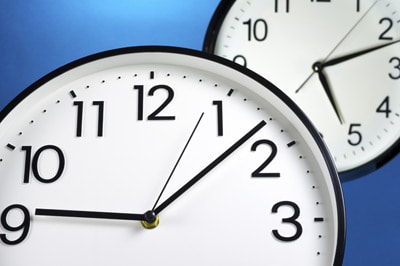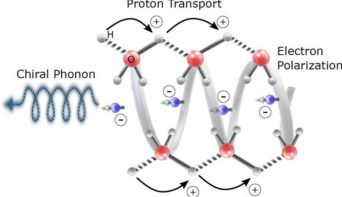
A new way of probing the intersection between quantum mechanics and Einstein’s general theory of relativity using interferometry has been devised by physicists in Israel. The researchers have developed a “self-interfering clock” that comprises two atomic spin states put into a quantum superposition. The researchers hope that their proof-of-principle experiment will provide new insights into the study of time, the interplay between quantum mechanics and relativity, and in particular the role that gravity could play in destroying the coherence of a quantum system.
Different ticks?
Quantum mechanics and general relativity are both well-established and well-tested theories. Despite this, the two are not always in agreement. The concept of time, for example, is treated differently by both: while quantum theory states that time is global and all clocks “tick” uniformly, general relativity dictates that time is influenced by gravitational fields, and so clocks tick at different rates in different places. The latter having been verified experimentally using clocks at different heights above the Earth.
Another inherent property of quantum mechanics is “superposition”, wherein a quantum particle such as an electron is considered to simultaneously be in all possible “states” (or spatial positions) until a measurement is made and the wavefunction collapses. This is more commonly known as the Schrödinger’s cat paradox.
Using an interferometer (the simplest being the double-slit experiment), researchers can make photons or electrons take two paths simultaneously. As long as the observer does not know which of the two paths is taken, when the paths are rejoined at a detector, an interference pattern – which is the hallmark of superposition – is seen, and the particles are thereby in spatial superpositions. On the other hand, if the observer is able to tell which path was taken, the interference pattern will disappear because there was no superposition. Such “which path” information can be revealed using a tag referred to as a “which path” witness. For example, a polarization filter placed in one path would allow the observer to distinguish light that had taken that path.
Which way?
So, what would happen if a “quantum clock” is simultaneously sent along two paths of an interferometer? General relativity says that time can “tick” at different rates along each path, and therefore time itself could be a “which path” witness.
This is precisely the question that Ron Folman and colleagues at the Ben-Gurion University of the Negev aimed to answer in their latest research. Thanks to the discovery of Bose–Einstein condensates (BEC) and the idea of using ultracold atoms as “clocks”, it is possible to send such a clock through an interferometer. “What we have shown in our proof-of-principle experiment is that time itself can also be a ‘which path’ witness,” says Folman. To do this, the researchers used ultra-cold rubidium atoms at nano-kelvin temperatures in a new Stern–Gerlach type of interferometer that they developed and demonstrated two years ago. Here, a strong magnetic field from an atomic chip interacts with the spin of the atoms, “and if the atom is in a superposition of two spin states, then it will evolve into a superposition of two momentum states that form (after some time) a spatial superposition”, explains Folman. In their latest experiment, the researchers do not actually send their clock down an interferometer – instead, two copies of the clock (wavepackets), are separated in space, thereby forming the two interferometer paths.
“We turn the atom into an atomic clock by manipulating its internal degrees of freedom (spin states),” says Folman, further explaining that as their clock is not sensitive enough to feel the different ticking rates caused by gravity, “we induce an artificial difference in the ticking rate by exposing the two paths to different magnetic fields that make the two clock wavepackets tick at different rates”. When the team actually induced its time lag – the wavepackets were put in easily differentiable orthogonal states – it found that the interference pattern disappeared, thereby proving that time may serve as a “which path” witness, according to the researchers.
Folman says that as the team was able to show revivals of the interference pattern, it is not clear yet if this may be called decoherence and there is a debate among theoreticians about the role general relativity may be playing. “Our proof-of-principle experiment opens the road to investigate this interplay,” he says. Indeed, recent theoretical work done by Časlav Brukner of the University of Vienna and colleagues looked into this, and suggested sending a cold-atom clock through an interferometer to test the boundary between the quantum and classical worlds, and Folman’s simulated interferometer clock is a first step in that direction.
Brukner tells physicsworld.com that the new work beautifully simulates what he and colleagues theoretically predicted about what a single “clock” – a time-evolving internal degree of freedom of a particle – undergoes when put in a superposition of regions of space–time with different ticking rates. “The time as shown by the clock is not well defined, and gets entangled with its position,” Brukner explains. He adds that “this implies that by ‘reading-out time’ from the clock, one could reveal the “which path” information, and consequently, one has a loss of coherence of the clock’s centre-of-motion degree of freedom”. This latest work “succeeded to demonstrate the very exact effect that we expect in a future experiment with a natural lag due to time dilation”, says Brukner.
Folman also points out that their device is a new type of interferometer that produces signals not seen before. “For example, people have become accustomed to the fact that when you join a split BEC, you always get an interference pattern in each repetition of the experiment. This new interferometer completely destroys the interference pattern of a BEC in every single repetition, when the two clock wavepackets have orthogonal time readings,” he says.
Higher sensitivities
Chad Orzel, a physicist at Union College in the US who was not involved in the work, says it is a clever idea, although he remains sceptical that this sort of mechanism could have anything to do with the quantum-to-classical transition because of the very small time lag that is induced. “In terms of implications for other experiments or tests of quantum gravity and the like, I think it will be a massive challenge to do anything with this. They’re using an artificial phase shift of order π between their clocks, and that much of a shift would be hard to realize with gravitational shifts near the Earth,” he says. Orzel adds that even if the technical challenges involved in developing a more sensitive clock (using say strontium) were surpassed, it would still be very difficult to show that it is indeed gravity degrading the contrast of interferometer fringes.
Folman acknowledges that the challenge now facing his team is to reach a sensitivity that would “allow us to directly observe the effect of general relativity on the interferometer. For this to happen, the distance between the two paths must be enlarged (so that the difference in ticking rate is larger) and the clock needs to be made much more accurate. It remains to be seen how quickly this can be achieved.” In addition to testing the overlap between relativity and quantum mechanics, the team hopes its work will help us to “learn more about time itself”.
The research is published in Science.




